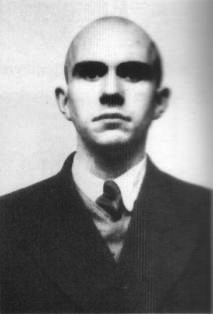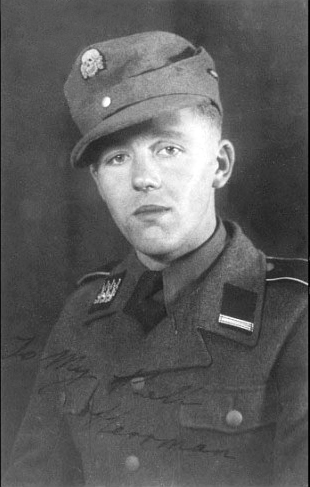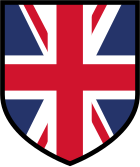
The Schutzstaffel was a major paramilitary organisation under Adolf Hitler and the Nazi Party in Nazi Germany, and later throughout German-occupied Europe during World War II.

The Waffen-SS was the combat branch of the Nazi Party's paramilitary Schutzstaffel (SS) organisation. Its formations included men from Nazi Germany, along with volunteers and conscripts from both German-occupied Europe and unoccupied lands. It was disbanded in May 1945.

Josef "Sepp" Dietrich was a German politician and SS commander during the Nazi era. He joined the Nazi Party in 1928 and was elected to the Reichstag of the Weimar Republic in 1930. Prior to 1929, Dietrich was Adolf Hitler's chauffeur and bodyguard.

The Waffen Grenadier Brigade of the SS Charlemagne was a Waffen-SS unit formed in September 1944 from French collaborationists, many of whom were already serving in various other German units.

Gottlob Christian Berger was a senior German Nazi official who held the rank of SS-Obergruppenführer und General der Waffen-SS and was the chief of the SS Main Office responsible for Schutzstaffel (SS) recruiting during World War II. At the post-war Nuremberg trials, the Waffen-SS – within which Berger was a senior officer – was declared to be a criminal organisation due to its major involvement in war crimes and crimes against humanity. Berger was convicted as a war criminal and spent six and a half years in prison.

John Amery was a British fascist and Nazi collaborator during World War II. He was the originator of the British Free Corps, a volunteer Waffen-SS unit composed of former British and Dominion prisoners-of-war.

Reginald Eric Pleasants was a British national who joined the Waffen-SS serving in the British Free Corps during the Second World War.

The Indian Legion, officially the Free India Legion or 950th (Indian) Infantry Regiment, was a military unit raised during the Second World War initially as part of the German Army and later the Waffen-SS from August 1944. Intended to serve as a liberation force for British-ruled India, it was made up of Indian prisoners of war and expatriates in Europe. Due to its origins in the Indian independence movement, it was known also as the "Tiger Legion", and the "Azad Hind Fauj". As part of the Waffen-SS it was known as the Indian Volunteer Legion of the Waffen-SS.

The Azerbaijani Legion was one of the foreign units of the Wehrmacht. It was formed in December 1941 on the Eastern Front as the Kaukasische-Mohammedanische Legion and was re-designated 1942 into two separate legions, the North Caucasian legion and the Azerbaijani legion. It was made up mainly of former Azerbaijani POW volunteers but also volunteers from other peoples in the area. It was part of the Ostlegionen. It was used to form the 162nd (Turkistan) Infanterie-Division of the Wehrmacht in 1943. similar to other Ostlegionen, it was organised to replenish the dwindling German manpower on the Eastern front and to "save the German blood at the front"
Douglas Webster St Aubyn Berneville-Claye, born Douglas Berneville Claye, was a British Nazi collaborator and member of the SS British Free Corps during the Second World War.

Roy Nicolas Courlander,, nicknamed 'Reg', was a British-born New Zealand soldier who became an Unterscharführer in the German Waffen-SS British Free Corps during the Second World War.

Thomas Haller Cooper, also known as Tom Böttcher, was a member of the German Waffen-SS British Free Corps and former member of the British Union of Fascists.

George Frank McLardy MPS was a member of the British Union of Fascists, a British Nazi collaborator and an Unterscharführer in the Waffen-SS British Free Corps during the Second World War.

Kenneth Edward Jordan Berry was a British seaman who was taken as a prisoner of war in 1940 when his ship was sunk. While in prison camp he was persuaded to join the British Free Corps of the Waffen-SS as an SS-Mann during the Second World War. He was associated with the unit until 29 April 1945, when he could not be found when the Corps were leaving Neustrelitz, and was left behind. He received a nine-month sentence after the war, 'the lightest sentence passed on any traitor'.

Alfred Vivian Minchin was a British merchant seaman who was taken prisoner by a German destroyer after his ship, the SS Empire Ranger, one of a Murmansk convoy, was sunk by German bombers off Norway. He held the rank of Sturmmann in the Waffen-SS British Free Corps during the Second World War. He was taken prisoner on 28 March 1942. It was he who suggested the name for the British Free Corps. By 8 March 1945 he 'was being treated for scabies in the SS hospital at Lichtefelde-West.' The National Archives holds the depositions for his trial at the Central Criminal Court under reference CRIM 1/485. and a Home Office file on him under reference HO 45/25817 He was "convicted at Central Criminal Court on 5 February 1946 of conspiring to assist the enemy and sentenced to 7 years' penal servitude" for offences against the Defence Regulations. He died in Somerset in February 1998 at the age of 81.

William Charles Brittain was a lance-corporal of the Royal Warwickshire Regiment who was serving in No. 4 Commando at the time of his capture in Suda Bay, Crete, in June 1941. During the Second World War he became a member of the "staff" at the PoW "holiday camp" in Genshagen, Berlin in mid-1943 and later a Rottenführer in the Waffen-SS British Free Corps. In February 1945 while in Dresden, he said he "had long since lost his enthusiasm for the unit and was planning to escape". During a conversation with his girlfriend, a Norwegian nurse, he boasted of his plans and also claimed that he had foreknowledge of the bombing raids. Shocked by this, she denounced him almost immediately to the Gestapo and the BFC were arrested en masse. "[His] court-martial ... took place at Colchester in June 1946 and he received a ten-year sentence. Two months later he was found to be suffering from an incurable form of Crohn's disease and he was released.
Henry Alfred Symonds was a British soldier who served in the British Free Corps of the Waffen-SS during World War II, attaining the rank of Rottenführer
Brigadier Leonard Parrington was a British Army officer. He joined the Royal Garrison Artillery in 1911 and served with them in the First World War in which he was mentioned in despatches four times and was awarded the Military Cross. In the inter-war period he was seconded as an adjutant to the Territorial Army in the East of England, as an instructor at the Indian Artillery School and as part of the British military mission to the Egyptian Army. Upon the outbreak of the Second World War Parrington was promoted to colonel; he became an acting brigadier in 1941 and was posted to Greece. Allied forces were pushed back during the German invasion and Parrington, in charge of the evacuation of remaining troops, was forced to surrender on 29 April 1941. In captivity he inspected German holiday camps set up for prisoners of war. He was mistakenly thought to be pro-Nazi and was recommended, without his knowledge, for command of the British Free Corps, a collaborationist unit of the German SS. Parrington retired from the army in 1946.


















